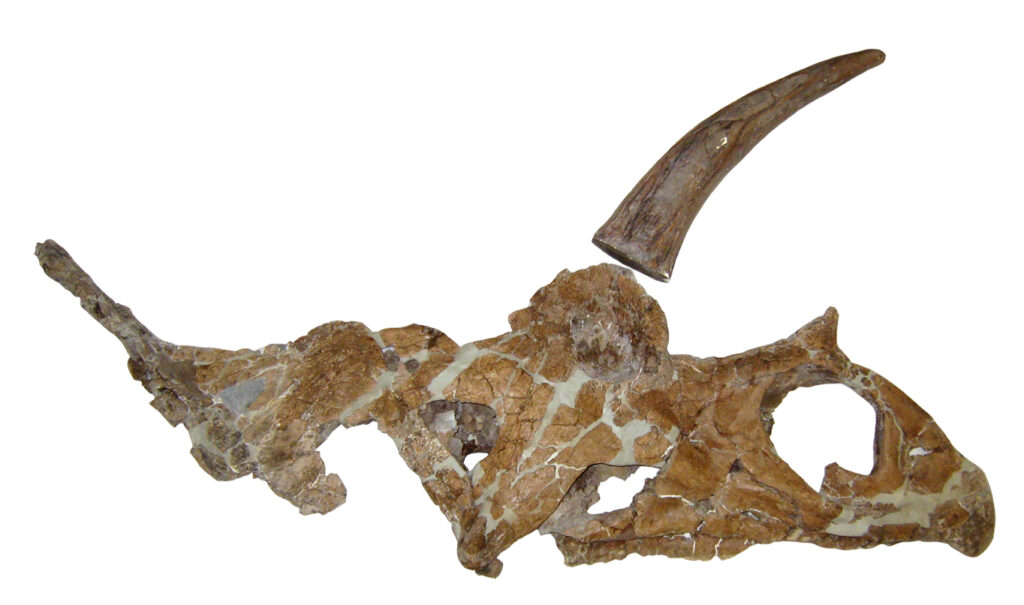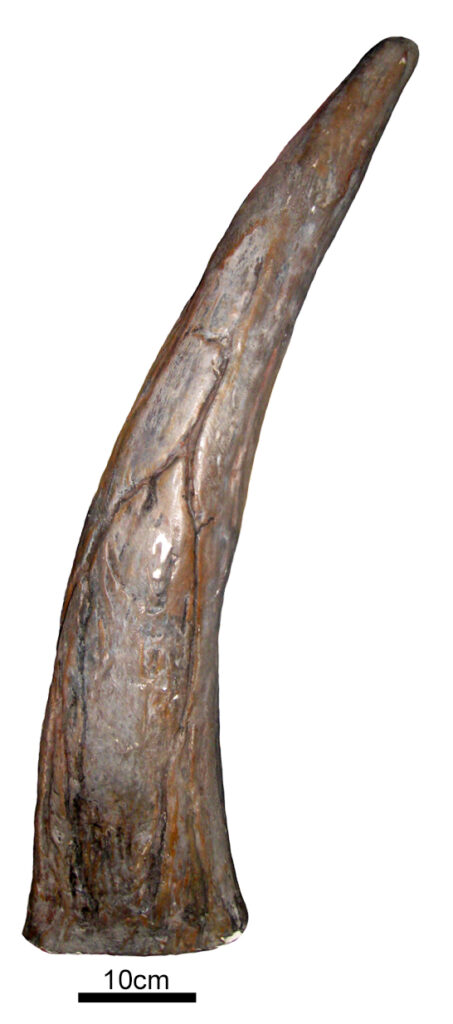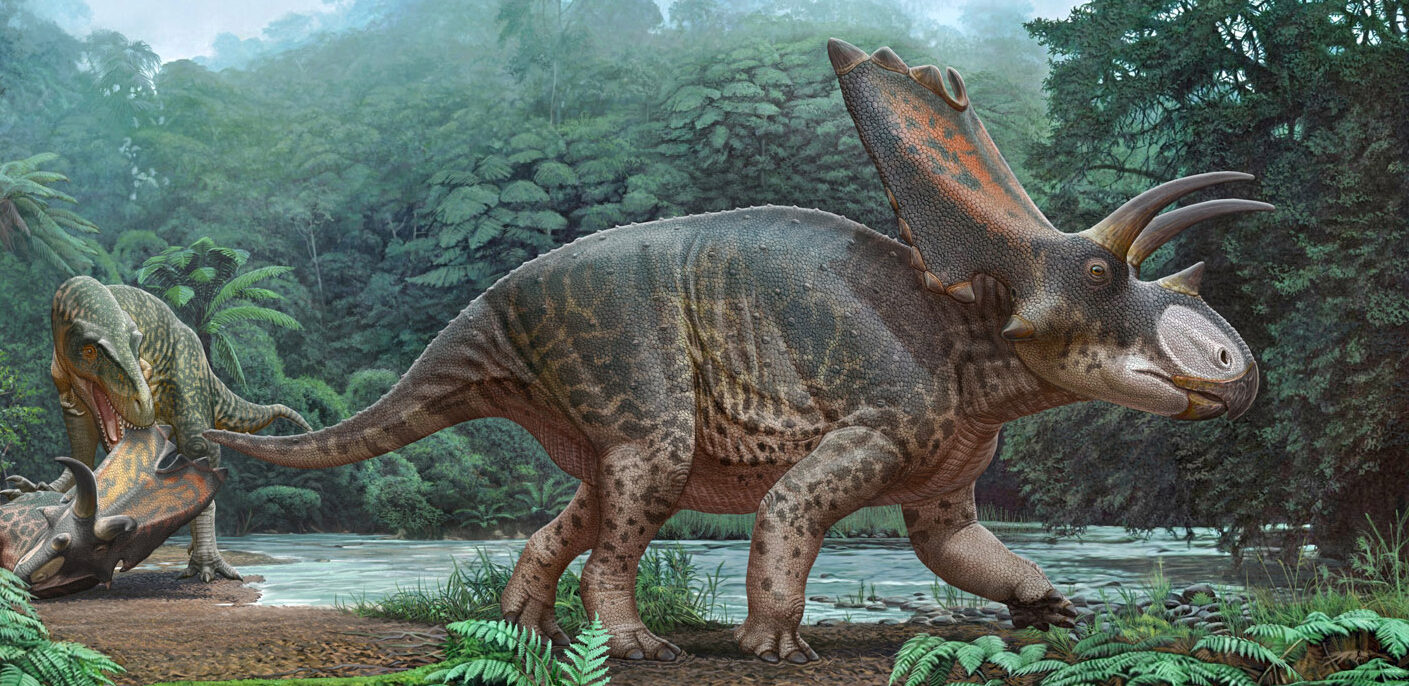A group of researchers, including Harrisburg University of Science and Technology Professor Dr. Steven Jasinski, recently named and described a newly discovered horned dinosaur species, marking the latest new species of horned dinosaur the team has named over the last few years.
Jasinski, of HU’s Department of Environmental Science and Sustainability, and researchers from the New Mexico Museum of Natural History and Science described Bisticeratops froeseorum, a newly discovered horned dinosaur from New Mexico that lived 74 million years ago.

The new horned dinosaur adds important new information to our knowledge of these iconic dinosaurs, according to a new study published in the scientific journal the Bulletin of the New Mexico Museum of Natural History and Science. The research was published by Jasinski, along with Research Associate Sebastian Dalman and Curator Dr. Spencer Lucas of the New Mexico Museum of Natural History and Science (NMMNHS).
In 1975, a field party from the University of Arizona was conducting field work in Upper Cretaceous rocks of the San Juan Basin, New Mexico, when they came across bone sticking out of the ground. Further digging revealed the nearly complete skull. This specimen was eventually transferred to the New Mexico Museum of Natural History, although it took decades before the skull was completely cleaned and prepared and more in-depth research was conducted on it.

Recent discoveries and a renewed effort by researchers to look back at specimens already collected and those in museum collections are providing us important new information. “Further investigation into specimens already in museum collections, combined with the collection and research into new specimens being collected, will allow us to understand these dinosaurs to an even greater degree” said Dr. Steven Jasinski.
Renewed research into this specimen revealed it to be a distinct dinosaur, named Bisticeratops froeseorum, with the genus meaning “Horned-face of the Bisti” region, referring to where the holotype specimen was found, and the species name honoring Edward and Jerome Froese and other members of the band Tangerine Dream.
Bisticeratops froeseorum belong to the group of dinosaurs known as ceratopsids, large, four-legged herbivorous dinosaurs known for having long horns and frills on their heads. The most famous member of the group is its younger cousin Triceratops. Bisticeratops lived around 7–8 million years before Triceratops and currently are only known from the southwestern United States. Bisticeratops also would have been a bit smaller, around 5–6 m long (around 16–20 feet long) and around 2.5–4 tons, making it similar in weight to female African elephants today or smaller males.
The recognition of Bisticeratops adds to a growing list of recent ceratopsid discoveries. These new discoveries are showing us these were a diverse group of dinosaurs at the end of the Cretaceous, just before their extinction with other non-avian dinosaurs.
“While only the skull of Bisticeratops was recovered, this fossil gives us a lot of information about horned dinosaurs at a time and place that was unique” Steven Jasinski said. “While other ceratopsids are known from older strata in this region, Bisticeratops potentially shows us the next step in the evolution of these horned dinosaurs in this region and fills in a gap leading to the last ceratopsid dinosaurs in this region before their extinction at the end-Cretaceous mass extinction.”
A phylogenetic analysis of the evolutionary relationships of Bisticeratops recovers this dinosaur as closely related to another chasmosaurine ceratopsid from the Late Cretaceous of Wyoming. This suggests these dinosaurs were migrating and moving north and south on the North American continent.
In addition to this adding to our knowledge of the diversity of ceratopsid dinosaurs, there are also features of the specimen that hint at the life history of Bisticeratops. The specimen has several bite marks on various parts of skull, including on the upper jaws, cheek, and frill. The placement and size of the bite marks suggests they were from a tyrannosaurid, potentially Bistahieversor, a tyrannosaurid known from slightly older strata (=rocks) in this region. Some of these bite marks suggest it survived the attack, while others look like they occurred after this individual Bisticeratops died. For these latter bite marks, we don’t know, however, if the tyrannosaur that made them hunted and killed this Bisticeratops, or if it came across the carcass and scavenged it.
Bisticeratops froeseorum adds to scientists’ understanding of the paleo-biodiversity of the American Southwest, offering a clearer picture of what life was like in this region near the end of the reign of the dinosaurs. “Not only are we able to gain a better understanding of the variety of different ceratopsid dinosaurs, but we also are able to see instances of interactions between some of the titans of these ecosystems,” Jasinski said. “This allows us a much clearer picture of life in this region 74 million years ago.”
The research team hopes future research will lead to be a better understanding of Bisticeratops’s ecosystem, and further our knowledge on the diversity and disparity among ceratopsid dinosaurs. While Triceratops may be the most famous of these dinosaurs, its family tree is growing.
To read the team’s paper describing Bisticeratops, visit this link or you may email Dr. Jasinski and ask for a PDF version: https://www.researchgate.net/publication/362680358_A_new_chasmosaurine_ceratopsid_from_the_Upper_Cretaceous_Campanian_Farmington_Member_of_the_Kirtland_Formation_New_Mexico.
Jasinski also was a member of another team that has recently named and described other new horned dinosaurs discovered in New Mexico. He and researchers from the New Mexico Museum of Natural History and Science, and the University of Pennsylvania, named the dinosaur species Menefeeceratops sealeyi. To learn more about this discovery, click here. He was part of another team of researchers from the New Mexico Museum of Natural History and Science and the University of Bath from the UK naming the dinosaur species Sierraceratops turneri. To learn more about this discovery, click here.
ABOUT HARRISBURG UNIVERSITY
Accredited by the Middle States Commission on Higher Education, Harrisburg University is a private nonprofit university offering bachelor and graduate degree programs in science, technology, and math fields. For more information on the University’s affordable demand-driven undergraduate and graduate programs, call 717-901-5146 or email, Connect@HarrisburgU.edu. Follow on Twitter (@HarrisburgU) and Facebook (Facebook.com/HarrisburgU).
